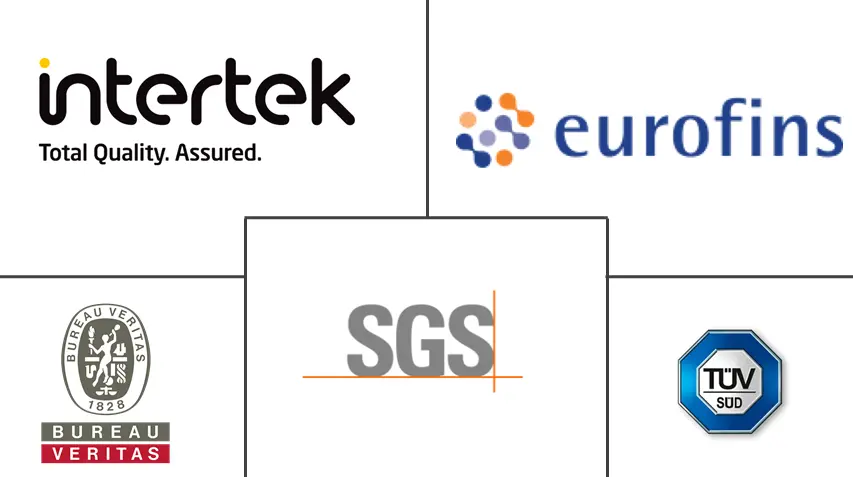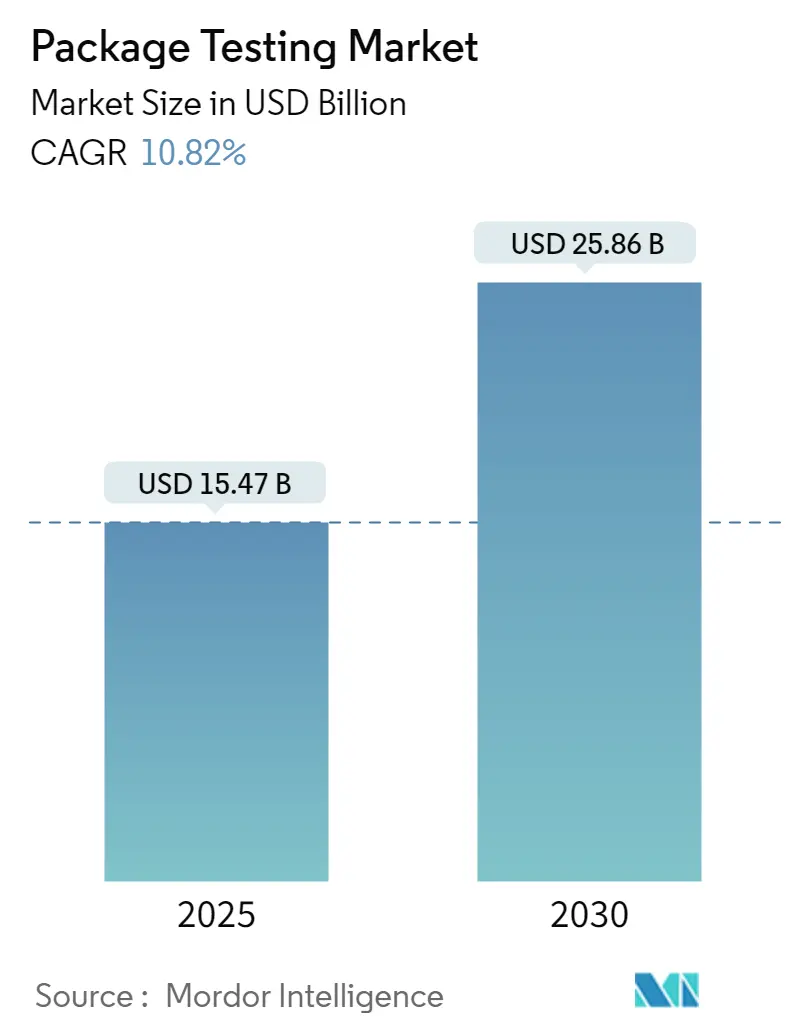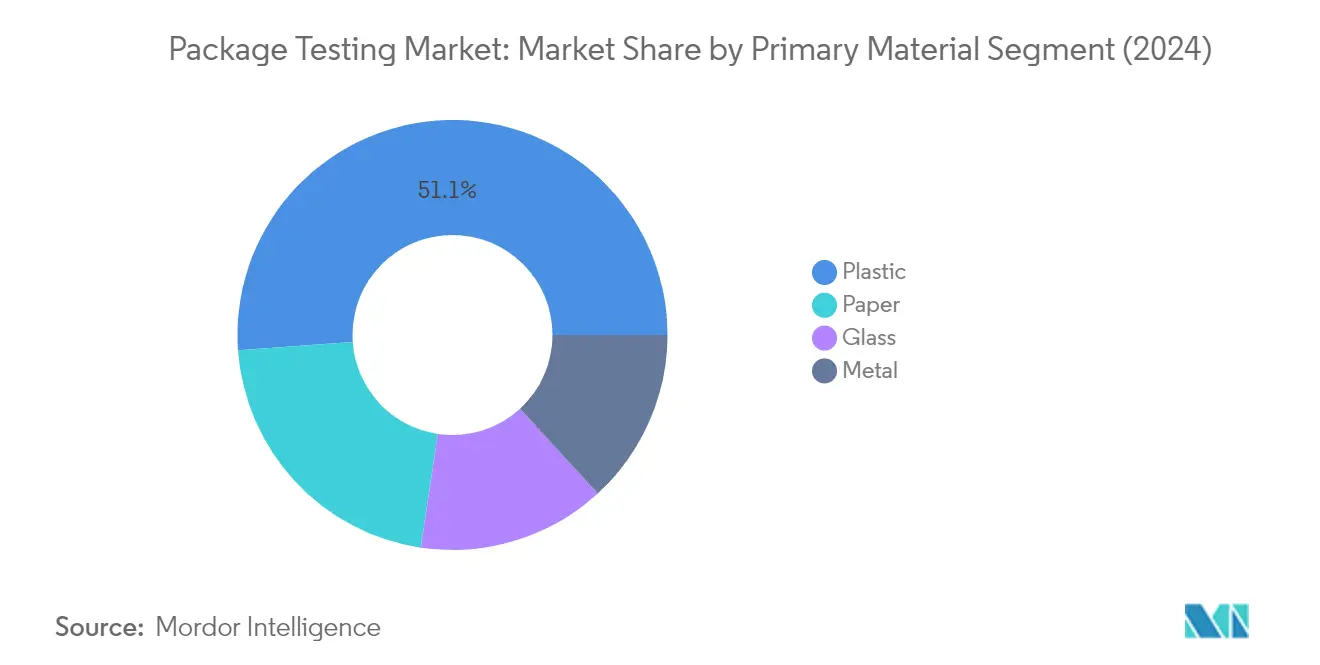Package Testing Market Analysis
The Package Testing Market size is estimated at USD 15.47 billion in 2025, and is expected to reach USD 25.86 billion by 2030, at a CAGR of 10.82% during the forecast period (2025-2030).
The package testing industry has evolved significantly amid global trade liberalization and improvements in transport infrastructure, fundamentally transforming how products are shipped and protected worldwide. The increasing complexity of international supply chains has necessitated more rigorous packaging inspection protocols to ensure product integrity across longer distances and varying environmental conditions. This transformation has been particularly evident in the food retail sector, where multinational companies have expanded their global presence. According to recent industry data, organic packaged food consumption in the United States reached USD 21.39 billion in 2022, highlighting the growing importance of reliable packaging materials testing solutions and testing protocols in the food sector. The reliability of packages is now tested through multiple sophisticated methods, including drop, vibration, and shock tests, guided by standard institutions such as ASTM and ISTA.
The rapid growth of e-commerce has revolutionized packaging requirements and testing protocols across industries. In the second quarter of 2022, U.S. retail e-commerce sales reached approximately USD 158.0 billion, demonstrating the sector's significant impact on packaging demands. This shift has led to the development of more specialized testing procedures for e-commerce packaging, with companies increasingly focusing on optimizing their packaging solutions for the unique challenges of online retail distribution channels. The evolution of consumer expectations regarding product delivery has prompted packaging companies to invest in advanced packaging quality control methodologies that simulate real-world conditions more accurately.
Technological innovation in package testing has accelerated significantly, with companies introducing sophisticated automated testing solutions. In August 2022, PACORR Testing Instruments launched an improved Box Compression Tester, designed specifically for manufacturers in the paper and packaging industries to evaluate packaging performance testing and quality. This advancement represents a broader industry trend toward automation and precision in testing procedures. Similarly, Mondi's EUR 280 million investment in 2022 across its corrugated packaging facilities in four countries demonstrates the industry's commitment to technological advancement and quality assurance.
Environmental sustainability has emerged as a crucial factor in package testing protocols, with increasing emphasis on evaluating eco-friendly packaging solutions. Companies are developing innovative testing methodologies for sustainable packaging materials, including biodegradable alternatives and recycled content. The industry has witnessed a significant shift toward testing protocols that assess both the environmental impact and performance capabilities of packaging materials. Testing facilities are now incorporating specialized procedures to evaluate the degradability, recyclability, and overall environmental footprint of packaging solutions, while maintaining strict performance standards for protection and durability.
Package Testing Market Trends
Rigorous Control Regulations and Administration and Qualification Demands
The package testing market is primarily driven by increasingly stringent regulatory frameworks and qualification requirements across global markets. The European Union's Packaging and Packaging Waste Directive mandates comprehensive packaging compliance testing protocols that require packaging to be manufactured for recovery or reuse while minimizing hazardous substances emissions from incineration or landfills. These regulations extend beyond basic safety parameters to include specific requirements for maintaining hygiene, structural integrity, and consumer acceptance levels for packed products. The implementation of multiple industry-specific standards, such as those established by the International Organisation for Standardisation (ISO) and the International Safe Transit Association (ISTA), has created a complex web of compliance requirements that manufacturers must navigate.
The evolution of packaging technologies, including intelligent packaging, active packaging, and modified atmosphere packaging, has further intensified the need for sophisticated testing protocols. These advanced packaging solutions require additional packaging validation and certification processes to ensure they meet both regulatory requirements and performance standards. For instance, food contact materials undergo comprehensive migration testing, while pharmaceutical packaging requires validation of sterility maintenance and barrier properties. The regulatory landscape has become particularly demanding for sustainable packaging initiatives, as demonstrated by Nestlé's March 2024 launch of sustainable KitKat packaging, which required extensive testing to verify both environmental claims and product protection capabilities. These rigorous requirements have made package testing an integral part of the product development and commercialization process across industries.
Demand for Longer Shelf Life of Products Under Varying Conditions and Growing Demand for Packaged and Sustainable Products
The increasing consumer preference for packaged products with extended shelf life, coupled with the growing emphasis on sustainable packaging solutions, is driving significant innovation in packaging compliance testing methodologies. Consumer demand for convenience and minimal waste has led to the development of sophisticated packaging solutions that require extensive testing to verify their ability to maintain product integrity under various environmental conditions. This trend is particularly evident in the organic food sector, where packaging must not only preserve product freshness but also maintain organic certification standards. According to the Organic Trade Association, the consumption of packaged organic food in the United States is projected to reach over USD 25 billion by 2025, up from USD 21.26 billion in 2021, highlighting the growing demand for reliable packaging solutions that can ensure product integrity and extended shelf life.
The surge in e-commerce and changing retail dynamics has further amplified the need for robust packaging integrity testing, as evidenced by recent retail trends. Census.gov reports that nonstore retailers experienced a 6.8% increase from the previous year, while food services and drinking establishments saw a 3.8% uptick from May 2023. These shifts in consumer purchasing patterns have necessitated the development of packaging solutions that can withstand various distribution challenges while maintaining product quality and safety. The industry has responded with innovations in barrier properties testing, seal integrity verification, and environmental stress testing to ensure that packaging can protect products throughout extended supply chains while meeting sustainability goals. This has led to the adoption of paper-based and other eco-friendly packaging solutions, each requiring specialized testing protocols to verify both their protective capabilities and environmental credentials. The need for packaging certification is thus integral to ensuring these solutions meet both regulatory and consumer expectations.
Segment Analysis: By Primary Material
Plastic Segment in Package Testing Market
The plastic segment dominates the package testing market, commanding approximately 51% of the total market share in 2024. This significant market position is driven by plastic's widespread use across various packaging applications, from food and beverages to healthcare and industrial products. The segment's prominence is further reinforced by the increasing adoption of multiple grades of plastic in various end-user industries and the growing focus on sustainable and biodegradable plastic packaging solutions. The versatility of plastic packaging, including its lightweight properties, chemical resistance, and effective barrier protection against oxygen and water, continues to drive demand for testing services, particularly in ensuring compliance with evolving environmental regulations and safety standards. The need for integrity of packaging seals is also critical in maintaining the quality and safety of products.
Paper Segment in Package Testing Market
The paper segment is emerging as the fastest-growing category in the package testing market, with a projected growth rate of approximately 13% during 2024-2029. This accelerated growth is primarily driven by the increasing adoption of sustainable packaging solutions and the rising environmental consciousness among consumers and businesses. The segment's expansion is further supported by innovations in paper-based packaging materials, including developments in moisture-resistant and durable paper products. Recent technological advancements in paper packaging, such as mono-material solutions and enhanced barrier properties, are creating new testing requirements and opportunities in the market. The role of stability testing for packaging is becoming increasingly important to ensure that these innovative materials meet the necessary performance standards.
Remaining Segments in Package Testing Market by Primary Material
The glass and metal segments continue to play crucial roles in the package testing market, each serving specific industry needs and applications. The glass segment maintains its importance in pharmaceutical, beverage, and premium product packaging, where material inertness and product preservation are paramount. Meanwhile, the metal segment remains vital in the food and beverage industry, particularly for products requiring long shelf life and robust protection. Both segments are experiencing ongoing innovations in lightweight solutions and recycling capabilities, driving the need for comprehensive testing services to ensure compliance with safety and quality standards.
Segment Analysis: By Type
Drop Test Segment in Package Testing Market
The Drop Test segment has emerged as the dominant testing type in the package testing market, holding approximately 25% market share in 2024. This significant market position is driven by the critical role drop testing for packages plays in simulating real-world falls and impacts that packages may encounter during shipping and handling. The segment's prominence is reinforced by its comprehensive testing methodology that evaluates packages through multiple drop orientations, including corners, edges, and faces in controlled environments. Major retailers and e-commerce companies increasingly rely on drop testing to validate their packaging designs, with companies like Amazon incorporating specific drop test requirements into their packaging certification programs. The segment's growth is further supported by the rising adoption of automated drop testing systems that provide more accurate and consistent results compared to manual testing methods.
Temperature Testing Segment in Package Testing Market
The Temperature Testing segment is experiencing the fastest growth trajectory in the package testing market, projected to grow at approximately 14% between 2024 and 2029. This accelerated growth is primarily driven by the increasing demand from pharmaceutical and food industries where temperature validation is crucial for product integrity. The segment's expansion is supported by technological advancements in temperature mapping capabilities and the growing need for cold chain verification processes. The rise in temperature-sensitive product shipments, particularly in the pharmaceutical and perishable goods sectors, has led to increased investment in sophisticated temperature testing equipment and methodologies. Additionally, the growing complexity of global supply chains and varying climatic conditions across different regions has made temperature testing an essential component of package validation processes.
Remaining Segments in Package Testing Market by Type
The package testing market encompasses several other significant testing types including vibration testing for packages, which simulates transportation conditions and mechanical stresses, and Shock Testing, which evaluates package resistance to sudden impacts. These segments play crucial roles in ensuring package integrity across different transportation and handling scenarios. The Vibration Testing segment is particularly important for evaluating packaging performance during transit, while Shock Testing focuses on assessing package durability under extreme conditions. Both segments continue to evolve with technological advancements in testing equipment and methodologies, contributing to the overall robustness of package testing processes. The market also includes various other specialized testing methods under the Other Types category, which collectively address specific industry requirements and regulatory compliance needs. The importance of leak detection in packaging is also emphasized in these processes to ensure the safety and quality of the products.
Segment Analysis: By End-User Industry
Food and Beverage Segment in Package Testing Market
The Food and Beverage (F&B) segment dominates the package testing market, commanding approximately 25% of the total market share in 2024. This segment's leadership position is driven by increased food safety awareness among consumers and stringent packaging and labeling mandates across various regions. The rising consumption of packaged and processed foods worldwide, particularly in urban areas, has created a robust demand for package testing services. The F&B industry's emphasis on maintaining product integrity, ensuring longer shelf life, and complying with various international safety standards has made package testing an essential component of their quality assurance process. The segment's growth is further supported by the increasing adoption of sustainable packaging solutions and the need for innovative testing methodologies to validate new packaging materials and designs. Additionally, the expansion of e-commerce in the food delivery sector has intensified the need for reliable package testing to ensure product safety during transit and storage.
Healthcare Segment in Package Testing Market
The Healthcare segment represents a rapidly expanding sector in the package testing market, with projections indicating substantial growth from 2024 to 2029. This growth is primarily driven by stringent regulations governing medical device and pharmaceutical packaging, particularly concerning sterility maintenance and product safety. The increasing complexity of healthcare packaging solutions, including smart packaging and controlled environment packaging, necessitates sophisticated testing protocols to ensure compliance with international standards such as ISO 11607. The segment's expansion is further fueled by the growing demand for innovative medical packaging solutions that can protect sensitive healthcare products during storage and transportation. The rise in pharmaceutical exports globally has also contributed to the increased need for comprehensive package testing services, as manufacturers must ensure their packaging meets various regional regulatory requirements while maintaining product integrity across different environmental conditions.
Remaining Segments in End-User Industry
The Industrial and Household & Personal Care segments, along with other end-user industries, constitute significant portions of the package testing market, each serving unique testing requirements. The Industrial segment focuses on testing packaging solutions for heavy-duty applications, chemicals, and industrial components, emphasizing durability and safety during transportation and storage. The Household & Personal Care segment primarily deals with testing packaging for cosmetics, personal care products, and household items, with a strong focus on consumer safety and product preservation. Other end-user industries, including automotive, electronics, and agriculture, require specialized testing services to ensure their packaging meets specific industry standards and environmental requirements. These segments collectively contribute to the market's diversity and drive innovation in testing methodologies to address evolving packaging challenges across different sectors.
Package Testing Market Geography Segment Analysis
Package Testing Market in North America
The North American package testing market maintains a dominant position, commanding approximately 32% of the global market share in 2024. The region's leadership is driven by stringent regulatory frameworks, particularly in the United States and Canada, governing packaging quality control and safety standards. The food and beverage industry serves as a primary growth catalyst, with increasing demand for packaged food products necessitating comprehensive package testing protocols. The healthcare sector's expanding requirements for sterile packaging solutions further amplify market growth. The region's robust e-commerce ecosystem has revolutionized packaging requirements, leading to increased adoption of package testing services to ensure product safety during transit. Additionally, the presence of major testing service providers and their state-of-the-art testing facilities contributes to market expansion. The emphasis on sustainable packaging solutions and environmental regulations has created new testing requirements, further driving market growth in the region.
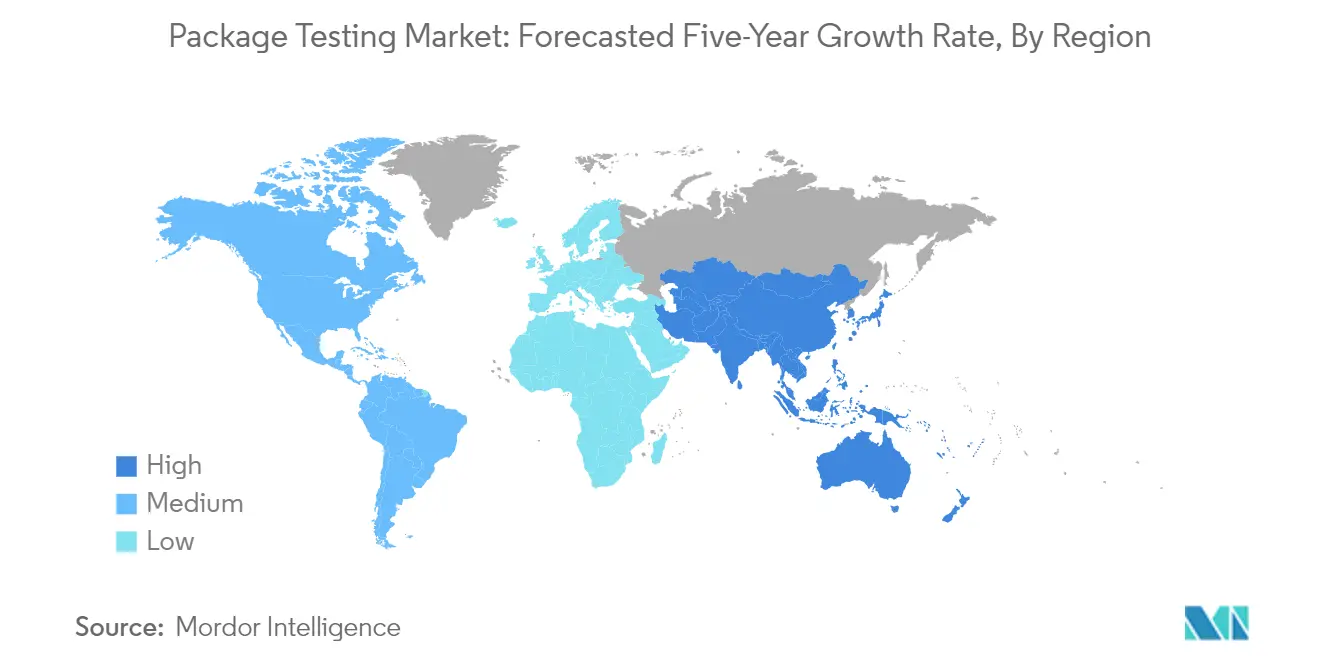
Package Testing Market in Europe
Europe represents a mature market for package testing services, demonstrating robust growth of approximately 13% annually from 2019 to 2024. The region's market is characterized by stringent EU regulations regarding packaging safety and environmental sustainability. The European market benefits from advanced testing infrastructure and a strong presence of leading testing service providers. The region's focus on circular economy initiatives and sustainable packaging solutions has created new opportunities for testing services. The pharmaceutical and medical device sectors contribute significantly to market growth, driven by strict requirements for sterile packaging and safety compliance. The region's emphasis on food safety and quality has led to increased demand for testing services in the food and beverage sector. Furthermore, the growing adoption of smart packaging solutions has introduced new testing requirements, while the expansion of e-commerce has necessitated more robust package testing protocols to ensure product protection during transit.
Package Testing Market in Asia Pacific
The Asia Pacific package testing market is positioned for exceptional growth, with a projected annual growth rate of approximately 13% from 2024 to 2029. The region's rapid industrialization and expanding manufacturing sector create substantial opportunities for package testing services. Rising consumer awareness regarding product safety and quality drives demand for comprehensive testing solutions. The region's burgeoning e-commerce sector necessitates robust packaging solutions, thereby increasing the need for testing services. Countries like China, Japan, and India lead market growth through their expanding pharmaceutical and food processing industries. The increasing adoption of international quality standards and regulations by regional manufacturers enhances the demand for testing services. Additionally, the growing middle class and changing consumer preferences toward packaged products contribute to market expansion. The region's focus on technological advancement in packaging solutions creates new testing requirements and opportunities for market growth.
Package Testing Market in Rest of the World
The Rest of the World region, encompassing the Middle East, Africa, and Latin America, demonstrates growing potential in the package testing market. These regions are experiencing increased adoption of international packaging standards and quality protocols. The Middle East's robust pharmaceutical and food processing sectors drive demand for testing services, while Africa's growing manufacturing base creates new opportunities. Latin America's expanding e-commerce sector and increasing focus on export quality standards contribute to market growth. The region's developing regulatory framework for packaging safety and quality creates new requirements for testing services. Additionally, increasing foreign direct investment in manufacturing sectors across these regions drives the need for comprehensive packaging validation solutions. The growing awareness of sustainable packaging and environmental regulations also influences market development in these regions.
Package Testing Industry Overview
Top Companies in Package Testing Market
The package testing market is characterized by the strong presence of established players like Intertek Group PLC, Eurofins Scientific SE, SGS SA, Bureau Veritas SA, and TÜV SÜD AG, who are driving innovation through advanced testing capabilities and digital transformation. These companies are actively expanding their service portfolios through investments in ISTA-certified laboratories, automated testing facilities, and specialized testing equipment for various packaging materials. Market leaders are pursuing strategic partnerships with e-commerce giants like Amazon through programs such as APASS (Amazon Packaging Support and Supplier Network), while simultaneously strengthening their positions through acquisitions of regional testing facilities. The industry is witnessing a significant push towards sustainable packaging certification solutions, with companies developing specialized capabilities for testing eco-friendly materials and implementing comprehensive testing protocols for recyclable packaging solutions.
Consolidated Market with Strong Global Players
The packaging testing market structure is dominated by large multinational corporations with extensive global networks of testing facilities and comprehensive service portfolios spanning multiple industries. These market leaders have established strong brand recognition through decades of experience, accreditations from various international standards organizations, and deep expertise across different packaging materials and testing methodologies. The market is experiencing rapid consolidation through strategic acquisitions, with major players actively acquiring smaller regional testing facilities and specialized laboratories to expand their geographical presence and technical capabilities.
The competitive dynamics are shaped by high entry barriers due to the need for significant capital investments in testing infrastructure, accreditations, and technical expertise. Market consolidation is particularly evident in developed regions like Europe and North America, where established players are strengthening their positions through vertical integration and expansion of service offerings. Regional players are maintaining their presence through specialized testing capabilities and strong local customer relationships, though they face increasing pressure from global players expanding their operations through both organic growth and acquisitions.
Innovation and Specialization Drive Market Success
Success in the package testing market increasingly depends on the ability to offer comprehensive testing solutions while maintaining technological leadership through continuous innovation. Companies need to invest in advanced testing capabilities, particularly in emerging areas such as sustainable packaging and e-commerce-specific requirements, while building strong relationships with key industry stakeholders. The development of specialized testing protocols for different end-user industries, particularly in highly regulated sectors like pharmaceuticals and food & beverage, is becoming crucial for maintaining a competitive advantage. Market players must also focus on digital transformation initiatives to improve testing efficiency and provide enhanced customer experience through automated reporting and real-time monitoring capabilities.
Future market success will be determined by the ability to adapt to evolving regulatory requirements and industry standards while maintaining operational efficiency and service quality. Companies need to develop strong partnerships with packaging manufacturers and end-users to understand emerging testing requirements and develop appropriate solutions. The increasing focus on sustainable packaging and circular economy principles is creating opportunities for testing providers to develop new capabilities and services. Market players must also consider the growing importance of regional compliance requirements and invest in building local expertise while maintaining global service standards. Success will increasingly depend on the ability to provide value-added services beyond basic testing, including consulting and advisory services related to packaging design and optimization. Additionally, the focus on packaging performance testing is becoming crucial as companies strive to meet the rigorous demands of various industries.
Package Testing Market Leaders
-
Intertek Group PLC
-
Eurofins Scientific SE
-
SGS SA
-
Bureau Veritas SA
-
TÜV SÜD AG
- *Disclaimer: Major Players sorted in no particular order
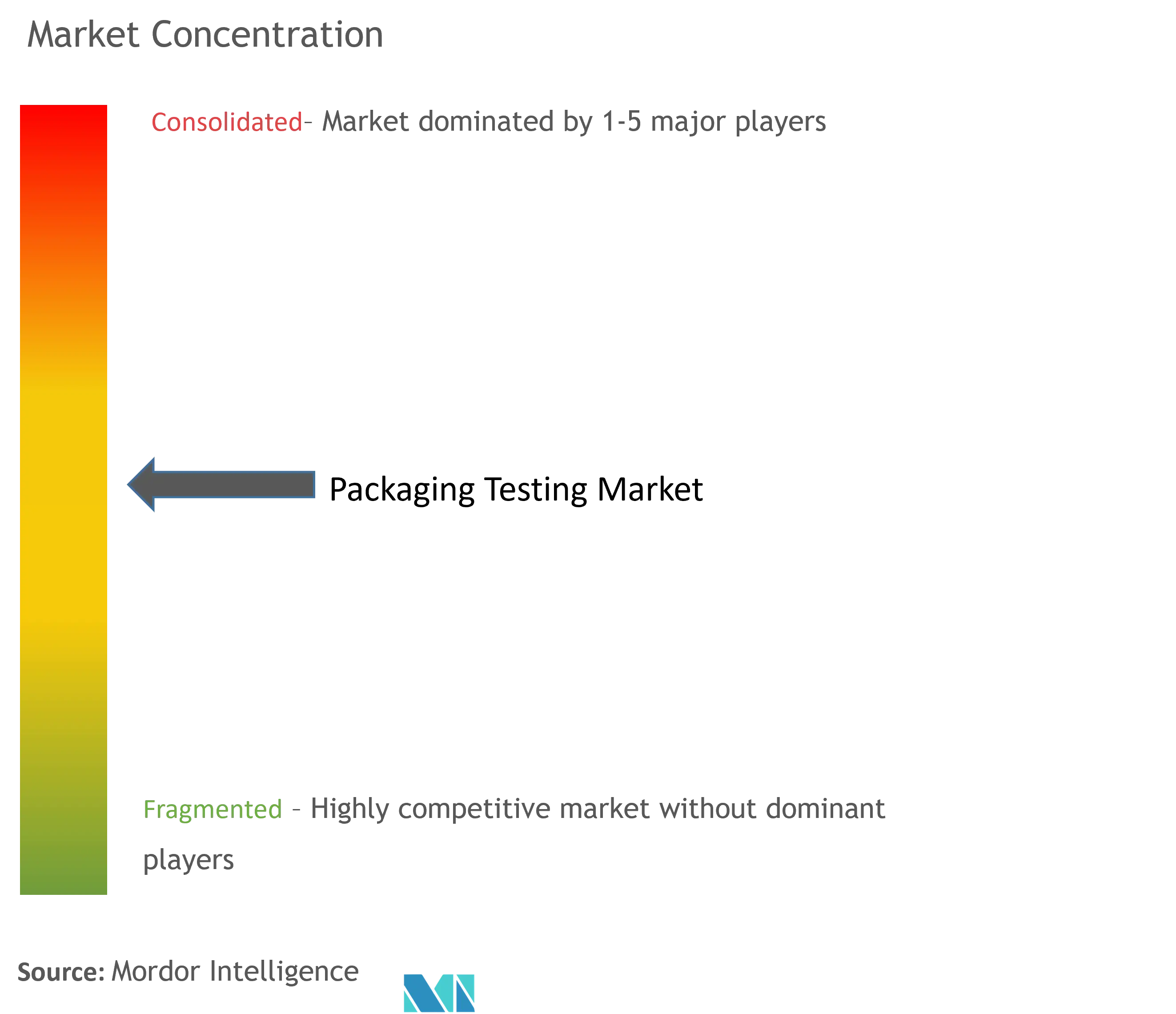
Package Testing Market News
- May 2024: Campden BRI revamped its membership package to assist producers and retailers in navigating an increasingly intricate landscape. The prominent food science entity bolsters a worldwide network, boasting over 4,000 member companies spanning 90+ countries. Campden BRI highlights that the food and beverage industry grapples with many challenges, from curbing environmental footprints and satisfying surging global appetites to enhancing productivity and innovating to align with evolving dietary and health trends.
- April 2024: Nefab Packaging Inc. acquired Plastiform Inc., along with its subsidiary, Precision Formed Plastics Inc., which specializes in top-tier thermoformed cushioning solutions crafted from recycled plastics. This strategic move bolsters Nefab Group's global market standing and underscores its dedication to resource conservation within supply chains. With this acquisition, Nefab solidifies its foothold in the Americas, enhancing its ability to cater to key sectors like datacom and cloud. Specifically, Nefab is equipped to provide these segments with thermoformed cushioning trays, all crafted from eco-friendly recycled plastics.
Package Testing Market Report - Table of Contents
1. INTRODUCTION
- 1.1 Study Assumption and Market Definition
- 1.2 Scope of the Study
2. RESEARCH METHODOLOGY
3. EXECUTIVE SUMMARY
4. MARKET INSIGHTS
- 4.1 Market Overview
-
4.2 Industry Attractiveness - Porter's Five Forces Analysis
- 4.2.1 Bargaining Power of Suppliers
- 4.2.2 Bargaining Power of Buyers
- 4.2.3 Threat of New Entrants
- 4.2.4 Threat of Substitute Products
- 4.2.5 Intensity of Competitive Rivalry
-
4.3 Technology Snapshot
- 4.3.1 Package Integrity Testing
- 4.3.2 Package Strength Testing
- 4.3.3 Package Shelf-Life Studies
- 4.3.4 Package Validation
- 4.4 Assessment of Macroeconomic Factors on the Market
-
4.5 Industry Policies
- 4.5.1 ASTM Standards
- 4.5.2 ISO Standards
- 4.5.3 STA Standards
5. MARKET DYNAMICS
-
5.1 Market Drivers
- 5.1.1 Rigorous Control Regulations and Administration and Qualification Demands
- 5.1.2 Demand for Longer Shelf Life of Products Under Varying Conditions and Growing Demand for Packaged and Sustainable Products
-
5.2 Market Restraints
- 5.2.1 High Costs Associated with Package Testing
6. MARKET SEGMENTATION
-
6.1 By Primary Material
- 6.1.1 Glass
- 6.1.2 Paper
- 6.1.3 Plastic
- 6.1.4 Metal
-
6.2 By Type
- 6.2.1 Drop Test
- 6.2.2 Vibration Test
- 6.2.3 Shock Test
- 6.2.4 Temperature Testing
- 6.2.5 Other Types (Compression Testing, Shelf Life Testing, Atmospheric Temperature Testing)
-
6.3 By End-user Industry
- 6.3.1 Food and Beverage
- 6.3.2 Industrial
- 6.3.3 Healthcare
- 6.3.4 Household and Personal Care Products
- 6.3.5 Other End-user Industries
-
6.4 By Geography***
- 6.4.1 North America
- 6.4.2 Europe
- 6.4.3 Asia
- 6.4.4 Australia and New Zealand
- 6.4.5 Latin America
- 6.4.6 Middle East and Africa
7. COMPETITIVE LANDSCAPE
-
7.1 Company Profiles*
- 7.1.1 Intertek Group PLC
- 7.1.2 Eurofins Scientific SE
- 7.1.3 SGS SA
- 7.1.4 Bureau Veritas SA
- 7.1.5 TUV SUD AG
- 7.1.6 Campden BRI
- 7.1.7 IFP Institute for Product Quality GmbH
- 7.1.8 DDL Inc. (Integreon Global)
- 7.1.9 Turner Packaging Limited
- 7.1.10 Nefab Group
8. INVESTMENT ANALYSIS
9. FUTURE OF THE MARKET
Package Testing Industry Segmentation
Package or packaging testing involves measuring a characteristic or property involved in packaging. It includes packaging materials, components, primary packages, shipping containers, unit loads, and the associated processes. The study tracks the key market parameters, underlying growth influencers, and major vendors operating in the industry, which supports the market estimations and growth rates over the forecast period. The study further analyzes the overall impact of macroeconomic factors on the ecosystem.
The package testing market is segmented by primary material (glass, paper, plastic, and metal), type (drop test, vibration test, shock test, temperature test, and other types [compression testing, shelf life testing, and atmospheric temperature testing]), end-user industry (food and beverage, industrial, healthcare, household and personal care products, and other end-user industries), and geography (North America, Europe, Asia-Pacific, and Rest of the World). The market sizes and forecasts are provided in value (USD) for all the above segments.
| By Primary Material | Glass |
| Paper | |
| Plastic | |
| Metal | |
| By Type | Drop Test |
| Vibration Test | |
| Shock Test | |
| Temperature Testing | |
| Other Types (Compression Testing, Shelf Life Testing, Atmospheric Temperature Testing) | |
| By End-user Industry | Food and Beverage |
| Industrial | |
| Healthcare | |
| Household and Personal Care Products | |
| Other End-user Industries | |
| By Geography*** | North America |
| Europe | |
| Asia | |
| Australia and New Zealand | |
| Latin America | |
| Middle East and Africa |
Package Testing Market Research FAQs
How big is the Package Testing Market?
The Package Testing Market size is expected to reach USD 15.47 billion in 2025 and grow at a CAGR of 10.82% to reach USD 25.86 billion by 2030.
What is the current Package Testing Market size?
In 2025, the Package Testing Market size is expected to reach USD 15.47 billion.
Who are the key players in Package Testing Market?
Intertek Group PLC, Eurofins Scientific SE, SGS SA, Bureau Veritas SA and TÜV SÜD AG are the major companies operating in the Package Testing Market.
Which is the fastest growing region in Package Testing Market?
Asia Pacific is estimated to grow at the highest CAGR over the forecast period (2025-2030).
Which region has the biggest share in Package Testing Market?
In 2025, the Europe accounts for the largest market share in Package Testing Market.
What years does this Package Testing Market cover, and what was the market size in 2024?
In 2024, the Package Testing Market size was estimated at USD 13.80 billion. The report covers the Package Testing Market historical market size for years: 2019, 2020, 2021, 2022, 2023 and 2024. The report also forecasts the Package Testing Market size for years: 2025, 2026, 2027, 2028, 2029 and 2030.
Our Best Selling Reports
Package Testing Market Research
Mordor Intelligence delivers comprehensive insights into the package testing industry. We leverage our extensive experience in packaging materials testing and quality assurance analysis. Our expert research covers crucial aspects such as packaging quality control, packaging inspection, and packaging integrity testing. This provides stakeholders with a detailed analysis of testing methodologies. The report, available as an easy-to-download PDF, thoroughly examines packaging validation processes and packaging certification requirements across global markets.
Our detailed analysis encompasses various testing methodologies. These include package drop testing, package vibration testing, and packaging leak detection procedures. The report provides valuable insights into packaging stability testing and packaging performance testing. It also addresses critical aspects of packaging seal integrity and packaging compliance testing. Stakeholders benefit from our in-depth coverage of industry trends, technological advancements, and regulatory requirements in the packaging testing market. This ensures they stay ahead of industry developments and maintain a competitive advantage through proper quality assurance measures.

